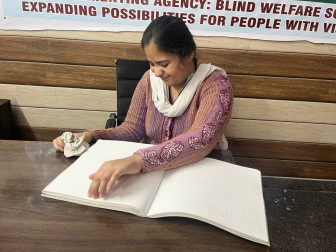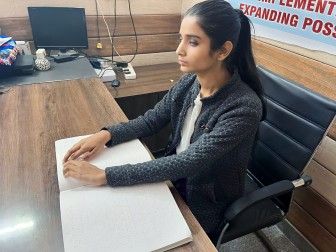In recent years, 3D printing has emerged as a groundbreaking technology with the potential to revolutionize various fields, from medicine to manufacturing. One of the most promising and impactful applications of 3D printing is in creating custom solutions for blind individuals. This innovative technology offers unique opportunities to enhance accessibility, independence, and quality of life for the visually impaired. In this blog, we will explore the various ways 3D printing is being utilized to develop customized aids, educational tools, and everyday objects tailored to the needs of blind individuals.
One of the most significant challenges faced by blind individuals is navigating unfamiliar environments. Traditional maps are of little use to someone who cannot see them, but 3D printing offers a solution through the creation of tactile maps and models. These tactile representations allow blind individuals to explore and understand spatial information through touch. For example, 3D printed maps of public buildings, parks, or city streets can help users familiarize themselves with new locations, enhancing their mobility and confidence.
Moreover, 3D printed models of landmarks, buildings, and even entire neighborhoods can be used for educational purposes, providing blind students with a tangible way to learn about geography and architecture. These models are not only informative but also empower blind individuals by giving them a greater sense of control over their surroundings.
Assistive devices play a crucial role in the daily lives of blind individuals, helping them perform tasks that sighted people take for granted. 3D printing enables the creation of highly customized assistive devices tailored to the specific needs and preferences of each user. For example, custom-made braille keyboards, braille watches, and even braille e-readers can be produced using 3D printing technology. These devices are not only functional but also affordable, as 3D printing reduces the cost of production compared to traditional manufacturing methods.
Another exciting application is the development of custom white canes. While standard white canes are effective, they are not always tailored to the individual’s height, grip preference, or walking style. With 3D printing, it is possible to create personalized white canes that offer better ergonomics and comfort, thereby improving the user’s overall mobility experience.
Education is a fundamental right, yet blind students often face significant barriers to accessing the same quality of education as their sighted peers. 3D printing is helping to bridge this gap by creating educational tools that are both accessible and engaging. For instance, 3D printed braille textbooks, tactile diagrams, and interactive learning aids can make complex subjects like mathematics, science, and art more accessible to blind students.
One particularly innovative application is the creation of 3D printed braille blocks, which can be used to teach braille literacy to young children in a fun and interactive way. These blocks can be customized with different braille characters and symbols, allowing teachers to create tailored learning experiences for each student. By making learning more accessible and enjoyable, 3D printing is helping to level the playing field for blind students.
Beyond assistive devices and educational tools, 3D printing is also being used to create everyday objects that enhance the independence and quality of life for blind individuals. For example, customized kitchen utensils with braille labels can help blind individuals cook more safely and confidently. Similarly, 3D printed clothing tags with braille information can assist with outfit selection, while tactile markings on household appliances can make them more user-friendly.
In addition to practical applications, 3D printing also allows for the creation of personalized items that reflect the user’s personality and preferences. From custom jewelry to personalized home decor, 3D printing enables blind individuals to express themselves creatively and enjoy the same level of customization as sighted people.
While the potential of 3D printing for blind individuals is immense, there are still challenges to overcome. One of the main obstacles is the need for specialized design skills to create effective and functional 3D printed objects. Collaboration between designers, engineers, and blind individuals is crucial to ensure that the final products meet the users’ needs and expectations. Additionally, accessibility to 3D printing technology and materials remains a challenge in many parts of the world.
Despite these challenges, the future of 3D printing for blind individuals is bright. Advances in technology, such as more affordable 3D printers and user-friendly design software, are making it easier for more people to benefit from this innovative technology. Furthermore, increased awareness and investment in inclusive design will continue to drive the development of new and improved 3D printed solutions for the visually impaired.
3D printing is transforming the lives of blind individuals by providing custom solutions that enhance accessibility, independence, and quality of life. From tactile maps and models to personalized assistive devices and educational tools, the applications of 3D printing are vast and varied. As technology continues to advance, we can expect to see even more innovative and impactful uses of 3D printing for the visually impaired, paving the way for a more inclusive and accessible world.
By embracing the potential of 3D printing, we can empower blind individuals to lead more independent, fulfilling lives and ensure that they have equal access to the opportunities and experiences that sighted people enjoy.
By contributing to our feature donation campaigns, you are not just supporting us,
you are fostering independence, education, and accessibility for the people with blindness.
We are providing free shelter, food and educational support to the abandoned visually impaired girls residing at BWS.
₹1105795
raised of ₹2000000 Goal
55%
2 Days left
554 Supporters
Maa and Papa weren’t the happiest when I was born. They thought I was a burden to them.
₹666390
raised of ₹2000000 Goal
33%
2 Days left
499 Supporters
The Walking Canes have proved a useful tool to millions of blind people in navigating their environments with confidence and ease.
At our organization, we provide a nurturing environment for visually impaired girls, helping them lead fulfilling lives despite their challenges.
The following stories highlight the transformative journey of these remarkable individuals within our organization.

Hailing from Delhi, Sneha came to Blind Welfare Society in July 2023.
.jpeg)
Hailing from a small village of Gwalior district, Madhya Pradesh, Archana came to Blind Welfare Society in July 2023

Chhavi’s journey is a testament to the transformative power of education and the invaluable support provided by the Blind Welfare Society.